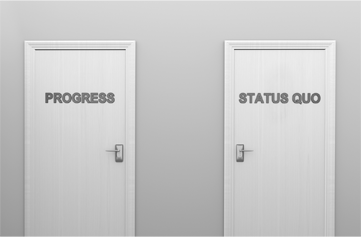There have been many examples of brands, which were “built to last”, that suffered a slow death due to silent internal factors and blind spots in the face of business climate changes and disruptions.
Here are four blind spots that, on the surface appear to be minor, but grow into sweeping blows to your business health, and in some cases are the real reason to complete business failure.
Intelligence Gathering: Assumptions vs Evidence-based
Making assumptions about your target audience’s behavior, buying patterns, and response to your sales and marketing efforts are dangerous. For example, it’s wrong to assume just because a brand gets a million likes on a social media post, that will translate into a reflective volume of sales for their upcoming product. Even simpler, more innocent assumptions that what resonates with the sales and marketing leadership team will also resonate with your target audience can lead you astray. Assumptions that do not prove true are painful, expensive, credibility-damaging and avoidable.
The most important assumption across all marketing and sales collateral is “we feel this could work, but we don’t know.” It’s why you need testing. To test is to know-on-demand across a small sample set. Testing is an artform and science in itself, where unfortunately, testing incorrectly can also lead to disconfirming results. Improperly administered tests could have had multiple issues, biases, and not as optimal as if done professionally.
Effective sales collateral testing typically adheres to the following:
- Representative Sample Set – Ensure the test subjects reflect the target market you are looking to Capture, Compel, and Close.
- Fixed vs Variable Parameters – It’s essential to keep various parameters fixed. For example, if you are testing a sales presentation and feel the slides where you build value and then discuss pricing require two different messaging approaches, then everything else should be fixed. For mission critical items like slides that affect a prospective client’s decision to work with you, you need to isolate for that one factor. This way you see the response and which format tests the best. Once this is settled, only then do you move to another mission critical item, say design color/layout/imagery, etc. Only one focused component should be changed at a time. Yes, it’s a lot of work but you’ll see via evidence-based results there is a huge conversion gap between a tested and recalibrated sales asset and untested original sales collateral.
- Focus Group vs Live Setting –The challenge with testing everything via only a focus group is that people don’t really behave in real life the way they say they do in a focus group environment. This makes it important to also test the focus group-refined assets in the field. Across a representative sample set in live sales-cycle settings you can confirm, reject, and again refine various elements of each asset tested.
- Unbiased Environment & Questioning Format – To avoid the dangers of groupthink, you must have an unbiased environment and questioning format that is as objective as possible. This is particularly relevant when having the open discussion portion of the focus group to gather feedback. Typically, it’s best to have the discussion part at the end of the session where most of the insights, feedback, and sentiments have been captured via written question. This way, the verbal group discussion does not impact the sentiments you want to capture and avoids groupthink, as it’s happening after each individual has provided their detailed written feedback.
- Live Testing Bias – In a live testing format the same team of sales executives must be trained to present the collateral in the same standardized approach in order to capture an accurate buyer sentiment. They will each have their own flavor of delivery, but will be playing the same song. It becomes troublesome when there is no consistency in how the sales collateral is being communicated
- Regional/Situation/Lead Type Variations – At the risk of complicating matters further, it’s essential that you take into consideration regional/situational/and lead type variances when testing the new sales collateral.
A regional variation could be that for your product/service is more relevant to businesses in major primary cities in the US, rather than rural/suburban communities. When testing the collateral you must factor this. A situational circumstance could be where one lead has a higher level of pain and urgency. They will be far more responsive, proactive, and engaged than a prospect who is finalizing a deal with a competitor and is in no rush, as this prospect has the security of already have a solution in place and are just giving you the space to present another option at the last minute. A lead type variation example would be using the new collateral on a past client for re-engagement, or a referred client from a trusted source, versus a cold call outreach who has no prior knowledge of your brand. These two different types of leads will all test differently. - Competitor Pricing Bias –This happens when the target client feels the competition has better pricing and terms, but may not be comparing apples to apples. Regardless of the new collateral, if you have a decades-long reputation of being a premium, yet outdated brand in a changing climate, if new disruptors have entered your market with better priced terms, you may have to overcome that psychological bias directly. This means highlighting that gap in their comparison and the exact additional features/service they receive with your solution.
Sales executives often have tunnel vision when learning how to best present the new collateral. They forget the context of the entire framework of the sale. For example, it’s critical to first determine the context of a sale. For instance, when it’s apparent that a prospective client views a competitor as a better option with superior pricing. Walking into a sales context like this, it’s imperative that the new collateral is not tested in autopilot. Rather, this core perception should first be examined in more detail with the prospect in order to directly address this context and then clear the path to test the new sales collateral.
In short, assumptions, big or small, lead into dangerous territory when you are developing optimal new sales collateral. So, you must test-test-test and factor in various biases and strategic steps to yield the best outcomes.
Culture Status Quo
The leadership culture in a company spreads to everyone working for that company. This internal brand is the core from which you build all other external factors.
There are 4 kinds of company cultures:

Looking at these closer, it’s clear that it’s not necessarily about if your culture is strong, good, bad, weak, poor etc. This is the “what” and obviously we all want it to be strong and positive. The distinction here is “how” is it? What is the directional flow?
A static company culture is a status-quo. It’s where regardless of new company hires, strategic directional changes, new market “disrupting” competitors, or overall economic climate, they remain the same, unchanged, and static. Examples of this include governmental organizations, defense contractors, large insurance firms, large medical groups, industrial brands, and big law firms. Typically, there are just too many people, leaders, and stakeholders. The best perceived part of this climate is the stability, as having a static culture is deemed safe.
A dynamic company culture usually has a core that is fixed, in terms of values, position, and vision for the company. But it also has a dynamic approach where the culture is flexible to different situations and departmental functions. It adjusts to the external market factors, as well as new senior hires internally. The key here is that it’s a strategic balance of having a solid, fixed foundational core and the flexibility to augment as needed given the variables the company encounters. Examples include entrepreneurial businesses, start-ups, media companies, fashion brands, change management consultancies, and e-commerce brands.
Inauthentic company culture is when there is inconsistency and contradiction between who a company says it is and the actions it takes. This can happen because of tensions at the leadership level or communication gaps between leadership and what’s happening on the front lines. It can also be caused by the need for internal politics to look good to other stakeholders. Or everyone having a different idea of what the culture is and presenting their version of it. Finally, it can be as simple as intentionally telling the audience what they want to hear (inauthentic branding) while having a totally different ideology internally (single focused profit maximization). This last point may sound sinister, but it has been apparent time and time again. For a more extreme example, British Petroleum took the action of inaction to fix the 2010 oil spill in the Gulf of Mexico and instead sprayed chemicals on the ocean surface to cover up the severity of the spill. The fact BP lied about the amount of oil it discharged into the gulf is well established. Lying to Congress about it was one of 14 felonies to which BP pleaded guilty in 2012. The resulting legal settlement with the Justice Department included a $4.5 billion fine, the largest fine ever levied against a corporation in the U.S. The inauthenticity was multi-layered as it rebranded itself “beyond petroleum,” as a totally new greenwashed brand doing good for the planet and environment.

A non-existent culture is just what it sounds like. This is when no thought, time, resources, or effort has been put into defining a core culture or ensuring leadership and employees adhere and promote it throughout the organization. This is prevalent in mid-size reactionary businesses who may have had many changes in leadership, financial struggles, and an overall reactionary approach to running the business.
“Culture eats strategy for breakfast.” – Peter Drucker. Every tool, tactic, strategy, and methodology falls flat without a strong company culture to take it from just an initiative to an actual working model across the entire organization. Culture is the liquid in the soup of business. Without it, you merely have ingredients being heated up until they’re burnt.
In our experience, the most superior culture is positively focused and dynamically goal-driven. This is because at the core, there are strong values of goodness and purpose that the whole company can stand behind. It also has dynamic application where the culture adapts to various businesses, competitors, and leadership changes in a highly progressive manner. This is a results-focused approach where the healthy culture results in a vibrant work environment, deeply respected co-workers who feel part of a larger progressive team, and clients who can literally feel the difference between this company and others.
Dated Brand Identity
Humans are visual creatures. When a company has a generic message, no core strategy, or relevancy that is apparent, and then packages all this with an outdated or unattractive brand identity, it is grossly limited in terms of market growth and new user adoption.
Even when a brand has aligned and meaningful messaging, a keen strategy, and relevancy, if their brand identity has not been updated and looks like a has-been brand, it hurts them. Things may not be extreme, like they have 20% of the sales levels of their largest competitors, but you can bet that they are leaving a significant piece of their business potential on the table for others who are better packaged.

Brand identity refers to all collateral the end client experiences from initial brand awareness marketing pieces all the way to post-sale client relations. Every collateral has a specific message, design, imagery, color scheme, layout, and design strategy embedded to influence a buying decision/perception. If this is flat, the sentiments of new prospective clients reviewing the brand for potential engagement will be too.
Many executives, even today, still harp that the high investment required for rebranding and creating world-class collateral is a “non-essential” expense. This is a culture and values problem – if they don’t value this investment and perceive that it will literally increase top-line revenues, then it’s difficult to break through that psychology. We have actually worked with a few companies who simply did not have the culture to support the work that was being done. What happens in these scenarios is that, at best, they deem the work as a cosmetic improvement but are unclear how their increased sales relate to the new collateral. And at worst, they do not use the new collateral effectively and see no real changes in performance, as it’s simply too difficult for them to adapt their culture to refresh at the same rate as the refreshed sales tools. These are factors we consider prior to taking on a new client, as it can end up as a wasted endeavor for all involved.
Reactive Strategy
The best feeling is when a company has been a “hidden secret” with an excellent team, a world-class product/service, and a vibrant brilliant culture to match. They are rapidly growing despite existing flaws they are aware of, and now they want to not only have the core substance, but develop the optimal brand identity to help their business grow by multiple factors. If this is you, we would LOVE to work with you.

Businesses are overwhelmed with too much information ,too much to do in a given day or week, and spread thin across all the ways they are demanded to perform across various business activities.
In sales development, it’s extremely easy to get caught up IN the business and not have time, or the energy to work ON the business
Activities that consume time working in the sales development part of the business include launching sales campaigns, screening new leads, servicing the sales-pipeline at each stage, inputting essential info into the CRM, reporting to management, emailing prospective clients, following up on proposals, holding presentations, and closing sales.
This is enough work to occupy a few people, yet it rests on the shoulders of each sales executive. When reviewing the tasks that are involved, it’s no surprise that a lot is done in a reactive manner, as so much activity is based on co-dependencies of prospective client’s schedules, emails, and actions. This becomes an environment of the need to perform at all times. There is no room to stop, reflect, work ON the sales development macro picture and organize things in a more strategically efficient and effective manner.
But what are the benefits of working ON the sales development aspects? What does that even look like? What elements would you even begin with? Okay, we hear you. Here is a list of areas to consider when transcending a reactive strategy to a more strategically proactive one:
- The kinds of clients you have – Your product/service is not for everyone. And furthermore, you genuinely enjoy working with certain kinds of prospective clients more than others. What are you doing to filter, sort, target, and win the exact kind of client that have the need, budget, and mindset to be an excellent potential client for you? The kinds of clients you have is a direct function of your sales outreach strategy versus a “spray and pray” approach.
- Deal size – If you are like most sales executives, then there is a bonus or percentage commission part of your compensation. This means the more sales you bring in, the more money you make. And so when you see deal size here, you’re probably thinking the larger the better.
What if the strategy was more about the lifetime value of the client instead of the immediate sale? What if getting small yeses up front leads to inevitable additional business down the sales pipeline/process? What if the sales style was far more to be a person of service as opposed to big game hunting?
When deal size is part of your core strategy then the kinds of leads you pursue, the manner in which you pursue them, and how you open and close them will be reflective. - Volume of deal flow – Again, when you take a step back to assess what kind of client is an ideal one, and what your sales capacity is in terms of prospecting/follow-up/presentation/deal closing, then you want a sales strategy that matches that, with optimal yield being harvested from these efforts. For some, the higher the deal flow the better. For others, they want limited deal flow, but the right kind of deals that have high probability to close and respective margins.
- Sales process & tools – Upon reflection, you may decide your entire sales process needs to be enhanced. The core sales story, branding and messaging, presentations, and every touchpoint needs an update and improvement. You want a sharper axe to cut with and a far better strategy to close more sales and serve more qualified potential clients. If this is the case, contact us, as we share this passion for using the best-in-class tools to directly impact the success rate of all your sales activities. The combination of seasoned sales executives, working in a proven sales process, with the best possible tools, and a supply of qualified sales leads is where magic happens. Be the spark.
- Time Management. The amount of time that is used to actually work on revenue producing activities (sales) versus the administration around it has become very concerning. Less time is being spent actually selling. The reason has to do with the inherent fear of rejection that comes with B2B prospecting, the sea of technologies for capturing client interaction notes and follow ups, the multiple ways sales executives can contact potential B2B sales prospects, and the simple procrastination that comes with being overwhelmed.

Managing your time effectively has become more critical now, than any time in the history of sales. EVERYONE is constantly being distracted and is pushed to multi/every-tasking things. There is a sea of noise we must penetrate to gain the attention of a sales prospect and then influence to a buying decision. This requires excellent time management and hourly focus resetting systems. The best approach we have seen is those who treat their time in 15-30 min increments, much like high powered attorneys who charge $1,500 hour and must keep their schedules productive.
We see close rates increase when sales executives have a formal session to work ON their sales process, method, strategy and recalibrate their trajectory to achieve their desired goals. Implement these principles and let us know how it’s going for you.

